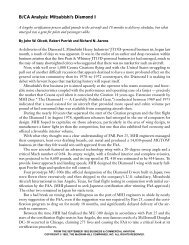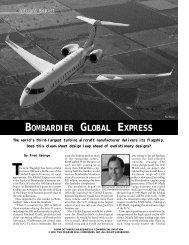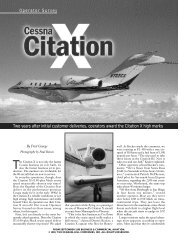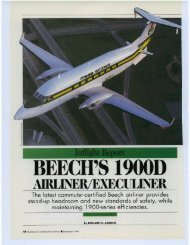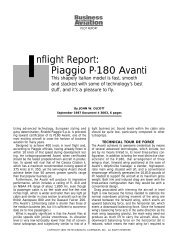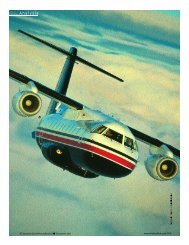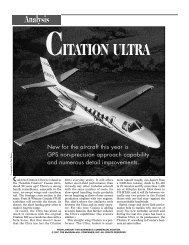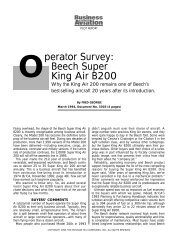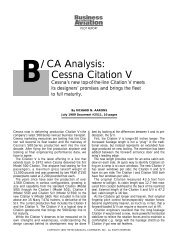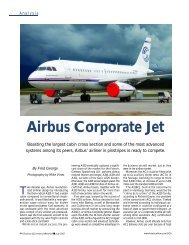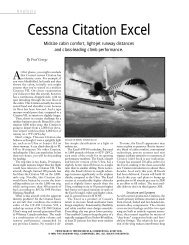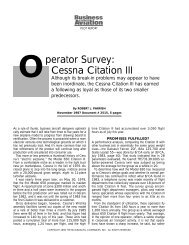731 Falcon 20B
731 Falcon 20B
731 Falcon 20B
Create successful ePaper yourself
Turn your PDF publications into a flip-book with our unique Google optimized e-Paper software.
Operations<br />
<strong>731</strong><br />
FALCON <strong>20B</strong><br />
T<br />
he Dassault <strong>Falcon</strong> 20 aircraft,<br />
arguably the matriarch of the mid-size<br />
class, seems to age as well as vintage<br />
Bordeaux wine. It offers one of the<br />
largest cabins in its class. It has airliner-like<br />
systems, such as fully-powered<br />
hydraulic control actuators, leading<br />
edge slats and glass windshields. It’s<br />
light on the controls, it’s easy to fly,<br />
and it’s hard to make a bad landing<br />
because of its long-travel, trailing-link<br />
landing gear.<br />
The availability of the first<br />
AlliedSignal TFE<strong>731</strong> turbofan engine<br />
retrofit in the late 1980s assures that<br />
the <strong>Falcon</strong> 20 will be in service well<br />
into the next century. Replacing the<br />
original GE CF700 engines with 4,500-<br />
pound-thrust TFE<strong>731</strong>-5AR turbofans<br />
boosts the range by as much as 65 percent.<br />
The <strong>731</strong> <strong>Falcon</strong> 20 also is a good<br />
neighbor because of its greatly reduced<br />
airport noise signature.<br />
The downside of the -5AR retrofit is<br />
longer takeoff field lengths, especially<br />
during hot-and-high departures. In<br />
addition, the -5AR conversion increases<br />
the BOW by 250 pounds, and the<br />
MTOW has been bumped up by 500<br />
pounds to 29,100 pounds. The added<br />
takeoff weight further lengthens the<br />
required runway compared to the original<br />
aircraft.<br />
In 1991, AlliedSignal and Dassault<br />
certificated the <strong>731</strong> <strong>Falcon</strong> <strong>20B</strong>, which<br />
is a second-generation engine retrofit<br />
program. TFE<strong>731</strong>-5BR engines, rated<br />
at 4,750 pounds of thrust for takeoff,<br />
replace the -5AR engines of the firstgeneration<br />
<strong>731</strong> <strong>Falcon</strong> 20. Compared<br />
to the -5AR engines, the -5BR turbofans<br />
have a high pressure ratio, more<br />
thrust and more flat-rating for takeoff,<br />
seven percent more climb and cruise<br />
thrust, and two percent better specific<br />
fuel consumption. Upgrading from<br />
-5AR to -5BR engines only adds 25<br />
pounds to the BOW, and the MTOW<br />
remains unchanged at 29,100 pounds.<br />
The additional thrust enables the<br />
<strong>731</strong> <strong>Falcon</strong> <strong>20B</strong> to climb directly to FL<br />
410. That’s 2,000 feet higher than the<br />
<strong>731</strong> <strong>Falcon</strong> 20’s initial cruise altitude<br />
This aircraft’s -5B engines greatly<br />
improve takeoff performance, especially<br />
when departing hot-and-high airports.<br />
143 lb/<br />
Second Total<br />
Inlet Air (Core and Bypass)<br />
LP Compression Core Engine Exhaust Combustion<br />
HP Compression Mixed Exhaust Bypass Exhaust<br />
and 4,000 feet higher than an unmodified<br />
<strong>Falcon</strong> 20. Under standard day<br />
conditions, the <strong>731</strong> <strong>Falcon</strong> <strong>20B</strong>’s extra<br />
thrust and better specific range result<br />
in two to three percent more range<br />
and slightly faster block times compared<br />
to the -5AR version.<br />
But, when departing from hot-andhigh<br />
airports, the -5BR engines give<br />
the <strong>731</strong> <strong>Falcon</strong> <strong>20B</strong> a marked increase<br />
in performance. For example, at 5,000<br />
feet, ISA+20°C, the -5BR-equipped<br />
aircraft can depart at 28,600 pounds,<br />
thereby endowing it with as much as<br />
500 nm more range than the -5AR version.<br />
Even more impressively, the <strong>731</strong><br />
<strong>Falcon</strong> <strong>20B</strong>’s roughly 2,000-nm range<br />
under such constraints is almost double<br />
that of a stock <strong>Falcon</strong> 20.<br />
It should be noted, however, that the<br />
<strong>731</strong> <strong>Falcon</strong> <strong>20B</strong> must make a flaps-up<br />
takeoff when departing under such<br />
hot-and-high conditions. That results<br />
in a takeoff field length of 11,805 feet.<br />
We flew AlliedSignal’s <strong>731</strong> <strong>Falcon</strong><br />
<strong>20B</strong> demonstrator on a short mission<br />
AlliedSignal TFE<strong>731</strong>-5BR<br />
Core Engine<br />
Bypass Duct<br />
111 lb/Second<br />
32 lb/<br />
Second<br />
to sample its improved climb and<br />
cruise performance. Departing San<br />
Diego Lindbergh Field at 28,500<br />
pounds, our takeoff field length was<br />
5,000 feet according to the approved<br />
flight manual. After takeoff, we were<br />
cleared for an unrestricted climb to<br />
FL 370. Dassault’s performance manual<br />
predicted a time to climb of 23<br />
minutes. Our actual climb time was 30<br />
minutes.<br />
After level off, the aircraft accelerated<br />
to 0.78 IMN, resulting in a true airspeed<br />
of 455 knots. Our fuel flow was<br />
1,700 pph. The book predicted 458<br />
knots with a fuel flow of 1,670 pph.<br />
Some of the variation between actual<br />
and book performance can be<br />
explained by the demonstrator’s being<br />
equipped with thrust reversers.<br />
The book performance numbers are<br />
based on non-thrust reverser exhaust<br />
nozzles.<br />
The current asking price for a mid-<br />
1970s vintage Dassault <strong>Falcon</strong> 20F is<br />
$1.8 million to $2.65 million, depend-<br />
Source: AlliedSignal/Rendered by Wendy Tittel<br />
FROM FEBRUARY 1997 BUSINESS & COMMERCIAL AVIATION.<br />
© 1997, THE McGRAW-HILL COMPANIES, INC. ALL RIGHTS RESERVED.
The additional<br />
thrust enables<br />
the <strong>731</strong> <strong>Falcon</strong><br />
<strong>20B</strong> to climb<br />
directly to FL 410.<br />
that’s comparable to the Hawker<br />
800XP.<br />
The average new, mid-size aircraft<br />
costs more than $10 million. The cost<br />
of a <strong>731</strong> <strong>Falcon</strong> <strong>20B</strong> ranges between<br />
$5.5 million and $8 million, depending<br />
upon base price of the unmodified airplane,<br />
plus options and cosmetic refurbishment.<br />
Those numbers suggest<br />
that the <strong>731</strong> <strong>Falcon</strong> <strong>20B</strong> will be well<br />
represented in the business aircraft<br />
fleet for several years to come. <br />
By Fred George<br />
ing upon age and condition. AlliedSignal’s<br />
price for the <strong>731</strong> <strong>Falcon</strong> <strong>20B</strong> conversion<br />
is $3.6 million, according to<br />
Don Sterling, manager of marketing<br />
and sales of the <strong>731</strong> <strong>Falcon</strong> <strong>20B</strong><br />
Retrofit Program. (If you already operate<br />
a <strong>731</strong> <strong>Falcon</strong> 20 with -5AR engines,<br />
upgrading to the <strong>731</strong> <strong>Falcon</strong> <strong>20B</strong> conversion<br />
costs $150,000 to $160,000 if<br />
the aircraft is enrolled in AlliedSignal’s<br />
Maintenance Service Plan.) Add<br />
in another $327,600 and 250 pounds if<br />
you want thrust reversers.<br />
A new digital avionics suite by<br />
AlliedSignal or Rockwell-Collins,<br />
including five-tube EFIS, runs about<br />
$1.3 million. Sterling claims that Garrett<br />
Aviation, with Dassault <strong>Falcon</strong><br />
Jet’s assistance, plans to obtain RVSM<br />
certification by the middle of this year.<br />
The current asking price for a fully<br />
completed <strong>731</strong> <strong>Falcon</strong> <strong>20B</strong> on the used<br />
market is $5.2 million, but there are<br />
very few on the market. It appears<br />
that <strong>731</strong> <strong>Falcon</strong> <strong>20B</strong>s are returning 80<br />
percent or more of the initial investment<br />
on resale.<br />
This may be explained by its performance<br />
in comparison to other, more<br />
contemporary mid-size aircraft. When<br />
needed, it can dash at 0.82 IMN at<br />
maximum cruise power. At a longrange<br />
cruise speed of 424 knots, it can<br />
carry eight passengers 2,258 nm with<br />
NBAA IFR reserves. Its specific range<br />
at 440 knots is 0.310 nm/lb, which is<br />
competitive with the latest business<br />
aircraft offering comparably sized cabins.<br />
Its operating costs are reasonably<br />
close to those of other aircraft in its<br />
class. Such performance numbers may<br />
explain why 90 <strong>Falcon</strong> 20 aircraft have<br />
been retrofitted with TFE<strong>731</strong> engines.<br />
In comparison to current-production<br />
mid-size aircraft, the <strong>731</strong> <strong>Falcon</strong> <strong>20B</strong><br />
has virtually the same range as a Learjet<br />
60, a cabin with essentially the<br />
same volume as a Hawker 1000 and<br />
standard-day runway performance<br />
FROM FEBRUARY 1997 BUSINESS & COMMERCIAL AVIATION.<br />
© 1997, THE McGRAW-HILL COMPANIES, INC. ALL RIGHTS RESERVED.



